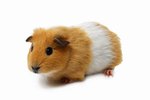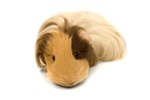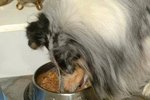
Australian bearded dragons are lizards of the Pogona genus. Their name derives from their ability to flare out the skin around their throats to make them appear larger. “Beardies” make attractive pets. Provided their captive habitat or vivarium is large enough and well-regulated for heat and ventilation, these social reptiles can thrive in captivity. Like certain snakes, bearded dragons are known for altering their body shapes, especially their stomachs. The reasons for doing so vary.
Fear Response
When a beardie thinks he’s in danger, he will instinctively flatten out his stomach and display it. This posture makes him appear larger and stronger than he actually is. Stomach flattening is done in order to avoid conflict rather than to invite it. If accompanied by a gaping mouth, it’s highly probable that your beardie is flattening his belly because something spooked him.
Illness
When a bearded dragon lays flat on the ground, it can appear as if he is deliberately flattening his belly. This isn’t always the case. A sick bearded dragon, especially one with an empty stomach due to lack of food, will lie flat because he hasn’t the energy or ability to move. An imbalance of calcium can cause your bearded dragon to flatten himself against the floor. If this posture is accompanied by a general listlessness, consult your veterinarian immediately.
Temperature Regulation
Because bearded dragons are cold-blooded creatures whose natural habitat has a hot desert climate, they need help regulating their temperatures effectively in captivity. Their digestion is temperature-dependent; if they are too cold, their food will simply rot in their stomachs. In order to warm up, a bearded dragon may flatten himself against a warm surface such as a rock or sunny spot in the garden. In your vivarium, he needs a basking rock and a light set to the appropriate temperature and height, in the right space.
Handling Your Bearded Dragon
When handling your beardie, it is essential to support him by the stomach, as this forms a large proportion of his entire body area. The beardie’s stomach is large and has four chambers. Because he is an omnivore, the bearded dragons requires the internal space to process both plant matter and meat.
References
Photo Credits
-
Hemera Technologies/AbleStock.com/Getty Images
Writer Bio
Simon Foden has been a freelance writer and editor since 1999. He began his writing career after graduating with a Bachelors of Arts degree in music from Salford University. He has contributed to and written for various magazines including "K9 Magazine" and "Pet Friendly Magazine." He has also written for Dogmagazine.net.




